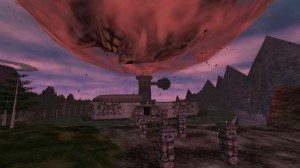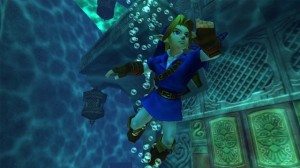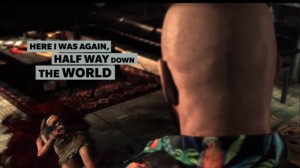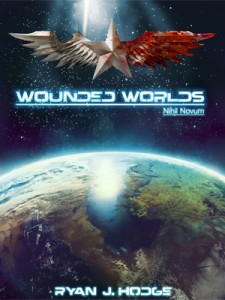-Ryan J. Hodge
For someone who enjoys a great story, is there anything better than a narrative that engages you from the very start? Imagine a world so rich you can almost smell the scents in the air, a delivery so clever it forces you to think in a way you never thought you would. I’m Ryan J. Hodge, author, and I’d like to talk to you about…Video Games.
Yes, Video Games. Those series of ‘bloops’ and blinking lights that –at least a while ago- society had seemed to convince itself had no redeeming qualities whatsoever. In this article series, I’m going to discuss how Donkey Kong, Grand Theft Auto, Call of Duty and even Candy Crush can change the way we tell stories forever.
What the Silent Protagonist Teaches Us About Environmental Storytelling
If you frequent any of the industry enthusiast sites for video games for any significant length of time, then you’re bound to run into one or two “Best Games of All Time” lists. While, like film or literature, there is no complete consensus; one will find certain titles appearing with some regularity. Titles like Half-Life, Half-Life 2, Portal, Bioshock, and some variant (or multiple variants) of The Legend of Zelda will make an appearance somewhere on these lists (and usually very near the top).
What is intriguing about these entries is that these are all heavily story focused games with a completely silent protagonist.

Well, I suppose ‘constantly shouting’ disqualifies one from being a *completely* silent protagonist.
The entire storyline of these games are completed without the main character saying a single word, and yet they are greatly praised for their story telling as well as gameplay. Now, how can this be? How can a story be affecting if it prompts zero reaction from our main character?
Well, in this fashion, games offer unique insight in that there is far more to a story than what may first meet the eye. If you have no ability to speak (and by this I mean, any fashion to communicate; verbally or otherwise), then the only avenue available to learn about your world is to listen and observe everything that’s happening around you. Just as it’s said that losing one of your senses heightens others, so too does losing the ability to communicate heighten observable details.
In Portal, players are introduced to the notion that they are human lab rats being made to run increasingly dangerous courses for the sake of some inscrutable scientific study. The environment is initially pristine, sterile, and full of difficult-to-maintain high tech gadgetry. Observation windows loom above every test chamber, and the entire affair seems to possess some semblance of order and planning. Yet, before long, minute cracks begin to appear in the façade. The ever-present observation windows are always empty. Your computerized proctor occasionally slips up with its pronouns (confusing ‘We’ and ‘I’). In later test chambers, alert players will find abandoned ‘nests’ of former test subjects adorned with empty food and water containers and mad scribblings that belie a prolonged absence of human interaction.
Through environmental cues alone, the player may conclude that the program running the ‘tests’ is actually a sophisticated AI that had gone insane long before the final reveal –and all without once demanding of another character “What the hell’s going on here!?” In fact, the addition of an expository character may very well have cheapened the entire experience. What more could a panicked last-survivor offer to the story that the endless cavalcade of hastily abandoned rooms couldn’t?
Half-Life (incidentally developed by the same company), offers a very similar experience to Portal. When a misbegotten experiment thrusts the entire Black Mesa Research Facility into an extra-dimensional alien invasion, the player (playing as theoretical physicist Gordon Freeman) is just as shocked and confused as his virtual ‘colleagues’. No one seems to know anything for sure, and the only concrete details consist of instructions on how to traverse the facility in search of someone who might know something.
Yet as the player stumbles from bad situations to worse ones, clues in his surroundings reveals much more about the disaster than initially thought. A crisply printed anatomical study of an alien life form exposes at once, and without a single line of dialogue, the fact that Black Mesa was aware of the trans-universal menace long before Freeman’s experiment went awry. The murderously brutal, efficient, and over-prepared military response carries with it the implication that anyone who might be confronted about this revelation is either dead or already far beyond the reach of our hero. Then there is the sinister ‘G-Man’; ever just beyond our reach, ever impossibly disappearing and reappearing around corners or locked doors inaccessible to the player. He divulges little, but his stilted cadence and impossible to place accent imply he may not be exactly ‘local’.
All of these details are left for the player to notice on his own accord. They are scarcely explained didactically, even in part, and that’s the entire fun of it! There is more satisfaction in the “A-ha!” moment than there could ever be in having these elements spelled out for the audience.
Contrast these elements with those presented in THQ’s Homefront. There is a moment in very early game, where the player’s character is taken on a grim and silent tour of the worst excesses of the US’ new Korean overlords. As we watch parents executed before their crying children, bodies heaped into dumpsters, and omni-present auto turrets looming over the proceedings; we, as audience members, are able to observe and draw our own conclusions about the current state of affairs. This state of reflection is abruptly soured, however, when the game’s primary non-player characters (NPCs) arrive.
These NPCs constantly bicker between themselves and dictate objectives to the player. They incessantly wail and curse upon witnessing the atrocities of the antagonists, and, in general, make it almost impossible for the player to be absorbed into the game’s atmosphere. As such, the audience is so over-saturated with information and interpretations from other characters that it no longer feels like it’s the player’s story.
This, however, is not the case with The Legend of Zelda: Majora’s Mask. In this title, the player (assuming the role of Link, the elven Hero of Time) finds himself in the bizarre, doomed world of Termina.
Given the radical departure from Hyrule (where Zelda games are typically set), the quirky behavior exhibited by Termina’s denizens might be easily dismissed. It feels more like a romp through Wonderland, and the parallels to Carroll’s classic actually illustrate my point. Where Alice was constantly questioning and interrupting the oddities that surrounded her, Link remains silent as he allows Majora’s characters to speak for themselves. However, while they can be rather chatty, these characters only reveal what must be revealed at the moment without needing to be prompted or breaking the flow of thought. As more exposition is made available, subtle patterns begin to emerge; patterns that might be lost or muted if Link was constantly chiming in with “What are you talking about? What do you mean?”
“You’ve met with a terrible fate, haven’t you?” is the first line of dialogue Link hears from the ‘Happy Mask Salesman’ after being transformed into a Deku Scrub. While it is indeed undeniably inconvenient, this line is repeated verbatim when the player fails his quest and allows Termina to be destroyed (thus killing everyone; including him). This, among other, suspiciously worded dialogue have led certain players to believe that Link is, in fact, already dead during the events of Majora’s Mask and that the dialogue and gameplay throughout is merely indicative of his journey through a sort of purgatory.
Yet this odd muting of the protagonist does smack a bit unnatural and out of place. In narrative outside of gaming, it is obviously strange for a protagonist to say nothing at all or offer no interpretation of the events unfolding around him. Shutter Island and The Wickerman both occur in dreamlike, surreal worlds and yet for the protagonists to not question what is occurring around them would certainly strain the Suspension of Disbelief.
We may resolve this dilemma by turning to Richard Matheson’s I Am Legend and assorted works of H.P. Lovecraft. In these stories, our protagonist is far from silent (in fact, he is speaking for the entirety of the narrative), however he does not often speak within the context of the narrative itself and instead serves as the vehicle for the story in that he is recounting his experience to the reader. As such, the protagonist’s dialogue (if he has any) is usually expedited and non-specific. Rather than rendering an entire conversation through dialogue, the author instead opts to assure the reader that a conversation happened at some point (i.e.: “I convinced the man to be my guide.”) but its details are unimportant. This frees the author to do two things, first: spend more time on environment, mood, and events. This allows the reader to seep into the story’s atmosphere and gives him time to ‘notice’ what perhaps even the protagonist does not. Second: call specific attention to any dialogue that is rendered in detail. Given that all other dialogue is expedited, any time the author stipulates exactly what was said automatically commands the reader’s attention. “Why is he saying this now? Why is he saying this in this manner?” This allows the reader to become a detective studying the plot for clues and attentive toward deeper meanings; all because the protagonist didn’t feel the need to verbally proclaim his every waking thought.
So grab a controller, sit down, and shut up. Who knows? It just might make you a better writer.
Ryan J. Hodge is a Science Fiction author and works for Konami Digital Entertainment US (His opinions are his own). His latest book, Wounded Worlds: Nihil Novum, is available now for eBook & Paperback.
You can now follow Ryan on Twitter @RJHodgeAuthor







